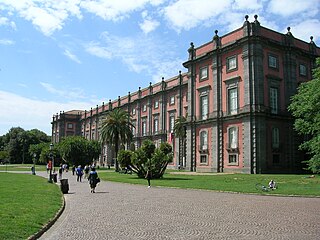
Masaccio, born Tommaso di Ser Giovanni di Simone, was a Florentine artist who is regarded as the first great Italian painter of the Quattrocento period of the Italian Renaissance. According to Vasari, Masaccio was the best painter of his generation because of his skill at imitating nature, recreating lifelike figures and movements as well as a convincing sense of three-dimensionality. He employed nudes and foreshortenings in his figures. This had seldom been done before him.

Tommaso Campanella, baptized Giovanni Domenico Campanella, was a Dominican friar, Italian philosopher, theologian, astrologer, and poet.

Luca Giordano was an Italian late Baroque painter and printmaker in etching. Fluent and decorative, he worked successfully in Naples and Rome, Florence and Venice, before spending a decade in Spain.

Antonello da Messina, properly Antonello di Giovanni di Antonio, but also called Antonello degli Antoni and Anglicized as Anthony of Messina, was an Italian painter from Messina, Sicily, active during the Early Italian Renaissance. His work shows strong influences from Early Netherlandish painting although there is no documentary evidence that he ever travelled beyond Italy. Giorgio Vasari credited him with the introduction of oil painting into Italy. Unusually for a south Italian artist of the Renaissance, his work proved influential on painters in northern Italy, especially in Venice.
Aniello Falcone was an Italian Baroque painter, active in Naples and noted for his painted depictions of battle scenes. Some sources refer to him as Ancillo Falcone.

Domenico Morelli was an Italian painter, who mainly produced historical and religious works. Morelli was immensely influential in the arts of the second half of the 19th century, both as director of the Accademia di Belle Arti in Naples, but also because of his rebelliousness against institutions: traits that flourished into the passionate, often patriotic, Romantic and later Symbolist subjects of his canvases. Morelli was the teacher of Vincenzo Petrocelli.

Girolamo Marchesi was an Italian painter of the Renaissance period.

Neroccio di Bartolomeo de' Landi (1447–1500) was an Italian painter and sculptor of the early-Renaissance or Quattrocento period in Siena.
Pompeo Landulfo was an Italian painter active mainly in Naples. He was born in Maddaloni near Caserta, Italy.

Abate Andrea Belvedere was an Italian painter of the Baroque period.

Michele Cascella was an Italian artist. Primarily known for his oil paintings and watercolours, he also worked in ceramics, lithography, and textiles. He exhibited regularly at the Venice Biennale from 1924 until 1942, and his works are owned by major museums in Italy and Europe, including Victoria and Albert Museum in London, Galerie nationale du Jeu de Paume in Paris, and Galleria Nazionale d'Arte Moderna in Rome.
Camillo Guerra was an Italian painter, active mainly in Naples, Italy.

Santa Maria delle Grazie is a Roman Catholic church located on Via Toledo, near its intersection with Via Diaz Armando, in central Naples, Italy.
Raimondo Scoppa was an Italian painter of both historical subjects and landscapes.

Francesco Saverio Netti was an Italian painter.
Ferdinando Ruggeri was an Italian painter, mainly painting historical and genre subjects.

Vincenzo Marinelli was an Italian painter, known best for his Orientalist canvases based on his travels in Greece, Crete, Egypt, and Sudan.
Niccolò di Tommaso was an Italian painter active in Florence, Naples and Pistoia.
Diana de Rosa, also known as Annella de Rosa or Annella di Massimo, was a seventeenth-century Neapolitan painter.
















